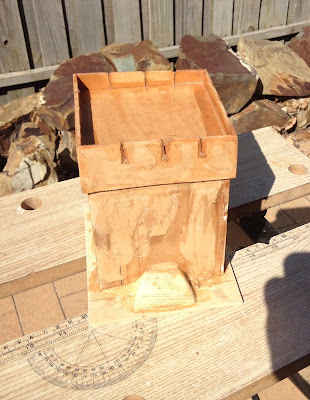One of the final items I wanted to add to my Hundred Years War (HYW) collection was a couple of buildings to represent a town. They had to have a limited footprint as I use a 6 inch gridded tabletop when wargaming and my HYW unit base size is 4 x 3 inches. With this constraint in mind the buildings would be built on a base size of 2 x 5 inches.
When making scratch built items I generally use balsa wood which is 1.5mm thick. Almost like a think card, but I find it easier to cut, light weight and easy to stick. The following pictures show the construction of the buildings.
 |
| I went with a simple design to fit the 2x5 inch base |
 |
| Added the roof |
 |
| With the second story another sheet of balsa was added to help differentiate levels (it helps with painting later) |
 |
| A second building was to have a thatched roof of PVA glue and fine flock |
These are buildings for wargaming and I find less detail equals less damage later when stored. Or shoved into a box. So most of the detail will be painted on. Where there are rough areas I use fine flock to create a textured surface which can get washed or highlighted with dry brushing during the painting process. The painting does not need to be too refined, just good enough to look ok at a distance.
 |
| A completed building on the table and in a square with troops |
The following pictures show some of the painting process. The roof was painted a mid-brown then a wash of a lighter yellow-brown was applied. Finally a few flicks of watered down dark brown we applied using a fine brush, mainly on the edges and ridge, to indicate a thatched roof.
 |
| Having painted the roof the walls were painted with a wash. When dry the detail is roughly added |
To get break up surfaces, such as walls, I paint one flat colour then dab on a second watered down colour. This reduces the flatness of the colour and suggests a texture on a flat surface. If I am not happy with the result, a dry brush of a lighter colour will often be sufficient.
 |
| A second colour is added to the beams to break up the colour and reduce the flat colour |
With windows I paint them a dark grey or brown to keep them in line with the building colour tone. As with most of the painting I water them down a fraction when painting. This also helps when you get something wrong, a quick wipe and the mistake is gone. Once dry I used a fine brush with a black to indicate a window frame.
 |
| Finally shadows or accentuation of details with watered down black |
Finally, before applying an acrylic sealer, I use a fine brush to add flicks of lines to indicate shadows and brick work as in the picture above.
 |
| The buildings with troops and a recently completed Keep |
The cost of the houses was about $1.50 for the sheet of balsa wood. In terms of time, one building can be constructed in an evening including drying time. Painting takes just over an hour allowing for drying time.
I get a lot of satisfaction from scratch building terrain. I remember reading all those early wargaming books where there was always a chapter detailing how to make your own terrain. Introduction to Battlegaming by Terry Wise was the most memorable for me.






































